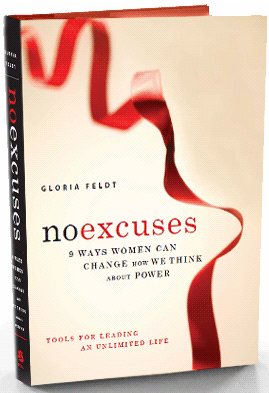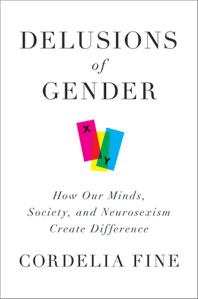Delusions of Gender
How Our Minds, Society, and Neurosexism Create Difference
By Cordelia Fine
The Female Brain
By Louann Brizendine
Just-so stories abound in our media about how women “naturally” talk too much, are over-emotional, bad at math, or just plain stupid. How much of it was earnest science badly reported and how much of it was just mean-spirited evolutionary psychology, I never knew. And somewhere, lurking in the darker corners of my brain was the thought that maybe it was all true; and grounded in strong, peer-reviewed science that was easily replicated. But when those doubts loomed, I would always stop myself – the difference between men and women on a genetic level is the difference between XX and XY. How could having a little more genetic material make me a stupid, frivolous, gold-digger compared to all the smart, serious, chivalrous men? It never made sense, but was that because I had a puny lady brain?
I read Louann Brizendine’s “The Female Brain” immediately before “Delusions of Gender.” It had been sitting on my bookshelf since it’s controversial publication. I read it first; knowing that it is one of the works Fine is highly critical of.
Brizendine acknowledges my quandary – if men and women have almost identical genetic makeup’s, how could our brains be so different as a result of biology alone? Her answer: hormones. The way I understood her hypothesis was that she saw men’s and women’s brains as computers with identical hard drive space and RAM. But estrogen and testosterone were like different operating systems – an iPhone and a Droid. This is a seductively simple point of view, and absurdities appear quickly. Brizendine actually suggests that women should schedule job interviews or oral exams on the days of their menstrual cycle when estrogen levels are highest because there is evidence that estrogen can increase verbal skills. When she also recommends not making important decisions while experiencing PMS or menstruation, it’s near impossible to take seriously.
Fine’s work is cut out for her as she proceeds to destroy Brizendine’s book and others like it (John Gray, etc). Her book is divided into three parts, “Half-Changed World, Half-Changed Minds”, “Neurosexism,” and “Recycling Gender.” She makes a convincing case that there is less evidence for hard wired sex based differences in behavior than most people think there is, and that actually there’s a lot of reasons to think men and women are similar in almost of the ways that the brain works.
It is common for parents to state that they know gender differences are real because although they have tried to be egalitarian, their little girl just loves her princess costume, and refuses to wear any color but pink. Fine questions the assumption that the parents are capable of bringing their children up in a world free of information about gender stereotypes. If all of the media they consume tells children how their gender is supposed to act, simply offering both a truck and a doll isn’t going to cut it. She then goes on to talk about how children, especially at preschool age, are trying to learn their place in the world. They don’t understand much about nationality, religion, or cliques. But they can latch on to the very salient gender stereotypes all around them.
The strongest evidence Fine presents for women’s intellectual equality with men are in the studies of what is called stereotype threat. The theory is that if you remind a person that they fit a stereotype of a person who is bad at the task at hand (math, for example) they will spend a lot of mental energy thinking about that fact rather than the actual task. One of the most shocking studies presented in “Delusions of Gender” was on this topic. The participants were enrolled in a calculus class. On average, the men and women had the same grades. In one group, the students were given a very difficult test and told that it was designed to try and find out what makes some people better at math than others. The average score was 19% correct for both genders. In the other group, students were told the same thing, but it was added that “despite testing on thousands of students, no gender difference had ever been found.” The women in this group scored a whopping 30% correct. If this evidence is to be believed, the amount of energy women spend trying to combat internalized sexism is tremendous. When these messages permeate our culture and our brains, they take so much away from our potential abilities. It may in fact be true that women have to work twice as hard to be considered half as good.
Finally, Fine makes the case that much neuroscience reporting is inaccurate, and favors studies that “prove” old tropes about gender to be true rather than communicating what was actually found. For example, women have a larger corpus collosum than men. (To the non-psychology majors reading: it’s the part of the brain in between the right and left hemispheres; what relays information back and forth.) This is said to explain things like why women are better at multi-tasking, and why men can’t talk about their feelings. The problem is that its simply not true; not only have fMRI imaging studies of the brain failed to show that women have more activity between hemispheres than men, but the fact is that if corpus collosum is correlated with anything it’s body size. People with larger bodies require slightly larger brains. “A large brain is simply not a smaller brain scaled up. Larger brains create different sorts of engineering problems and so – to minimize energy demands, wiring costs, communication times – there are physical reasons for different arrangements and different sized brains.” This is quite an important fact and it is routinely ignored.
Some reviewers on Amazon.com have criticized Fine’s sarcastic humor and at times downright flippant tone. I found her delightful. It can be tedious and overwhelming to realize that so much of what you have been taught is wrong. But Fine does it with style and is never tedious. One of my favorite parts was when she skewers those who spout sexist beliefs under the cover of “speaking truth to power.” Fine reigns them in and does the world a great public service.



